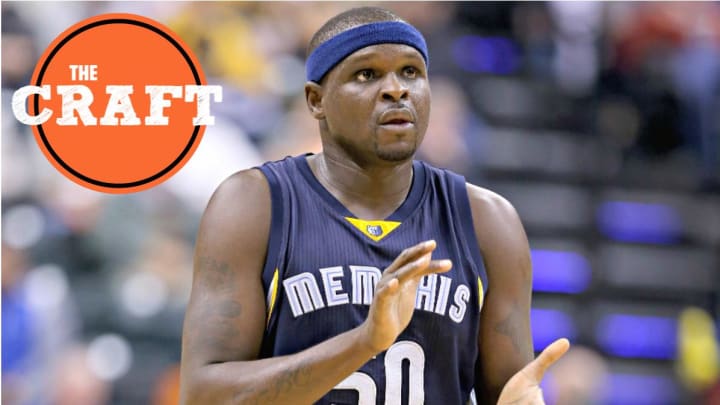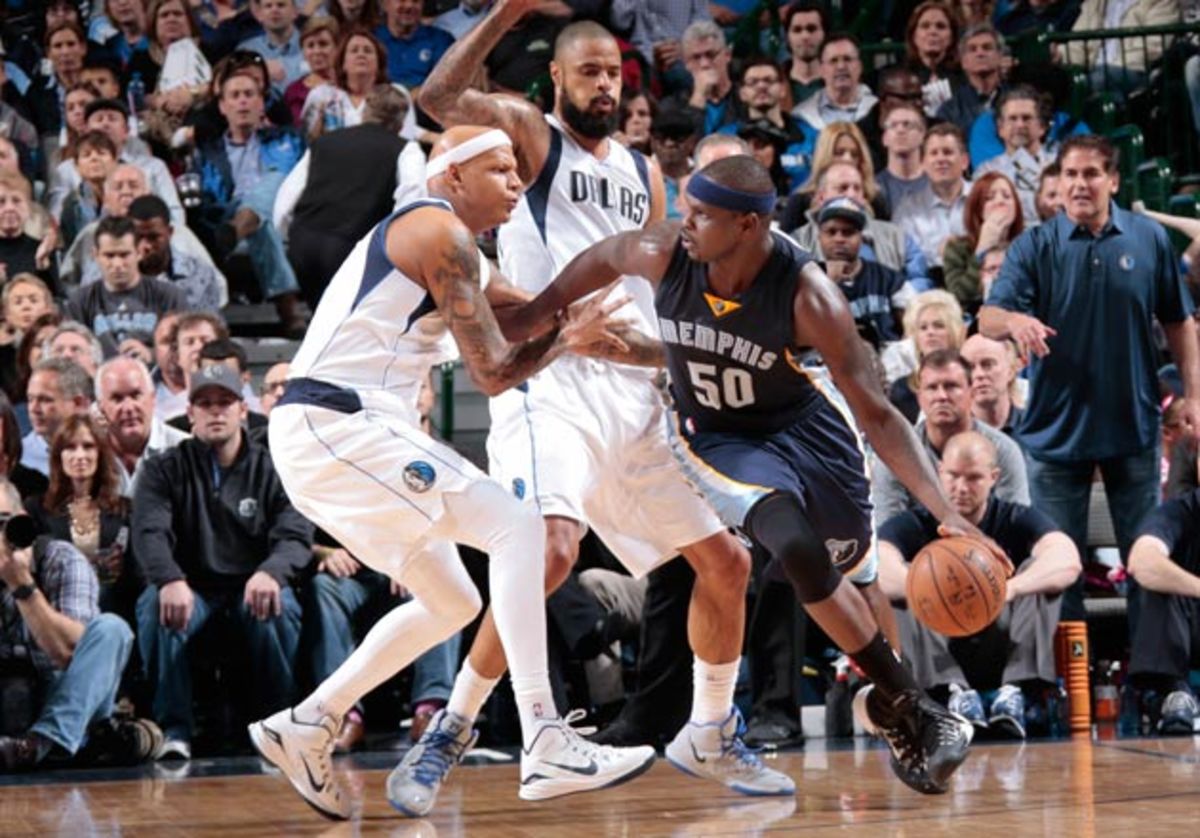The Craft: Zach Randolph reigns through pivots and patience

Welcome to The Craft, a serial look inside the world of player development in the NBA.
As Zach Randolph sees it, there is no blank slate—at least when it comes to post play. Talented bigs come into the league at 19 and 20 years old with nothing but time to address their most concerning weaknesses. Yet all of the technical training in the world can't overwrite the need for certain qualities that cannot be learned and cannot be taught.
"You can't teach footwork," Randolph said. "I mean you can, but you've gotta have that feel, you've gotta have that knack. It's a lot, reading a guy. If a guy's on your body, your instinct tells you to step through, push them off, or jab them. It all has to do with instincts and feel."
The truth of Randolph's perspective rings in the short careers of countless seven-footers. NBA history is littered with forced post play and overly mechanical hook shots, as the payoff in pounding the ball down low was once so great as to warrant trying out any physically able big man on the block. No more. The game has evolved to the point where the vast majority of players working the post with regularity are those most comfortable in that space. Without the feel that Randolph describes, there's really no use.
• THE CRAFT: Andre Drummond | Wes Matthews | Dante Exum | Tyson Chandler
Randolph, though, has always been a low-post prodigy. That his career started slowly (Randolph averaged just 5.8 minutes in just 41 games as a rookie) had more to do with context than readiness; the 20-year-old power forward joined a 50-win Blazers team loaded with established players in the frontcourt. There was no choice but for Randolph to wait his turn.
"I came in with a bunch of veteran guys in Portland and learned from them—practiced against them every day, going hard," Randolph said. "That's how I got my game, by going against Rasheed [Wallace], Shawn [Kemp], Dale Davis, Arvydas Sabonis, Scottie Pippen, Steve Kerr, those guys. Just being there and practicing hard every day."
By his second season, even a relatively green Randolph couldn't be kept from the rotation. His total minutes quadrupled, and by the midpoint of a seven-game series against the Mavericks in the first round, Randolph had assumed a spot in the Blazers' giant starting lineup—first alongside Wallace and Davis, later with Wallace and Sabonis. In his four starts in that series, Randolph averaged 20.5 points and 11 rebounds per game. He started 80 of 81 games for Portland the following season and has started in roughly 95 percent of his career games since.
• MORE NBA: Steph Curry takes lead on youth basketball
During that series, the Mavericks—whom Randolph bullied into near submission although they once held a 3-0 series lead—and the NBA at large began to realize what Randolph might be capable of on the basketball court.
Shot blockers couldn't keep up with Randolph's nimble swoops to the lane, giving him free looks at short-range hook shots. Those who could keep step with Randolph were generally vulnerable to his back-downs, movable to the point where he could find scoring opportunities through pivots and patience.
Guarding Randolph wasn't just a chore—it was a hopeless bind. So much so that he began to see committed double teams with regularity and couldn't quite see his way out of them.
"I struggled," Randolph said. "I used to ask Coach [Maurice] Cheeks, 'Why are they double-teaming me?' And he was like, 'Just take it as a respect thing. Some guys you can't play just one-on-one because you can't guard them.' But why they double-teaming me? Just let me play like everybody else plays."
This is the standard curve for any young scorer. Put up points consistently enough and you'll earn its attention. The best players find ways to operate through or around that pressure—tactical workarounds, counter moves, release passes. Randolph's first instinct was to protect the ball. In doing so, however, he often lost precious time and passing angles that could have been used to create an open shot.
NBA Power Rankings: Clippers rise, but are they true contenders?
For years this was taken as selfishness—corroboration of whatever character flaws were seen in Randolph and those legally troubled Trail Blazers teams. With the benefit of hindsight, it's evident that Randolph's greatest gains have come through broadened awareness. There are reels of film showing Randolph finding teammates in Memphis that he couldn't in Portland. He was bottled or baited into shooting too easily for the simple reason that he hadn't encountered that level of defensive pressure before. His maturation was a function of his experience.
Through it he would become a rock for Memphis and help reshape the franchise's identity. Randolph insists these are the only stages of his career that much matter: Those early years with the Blazers in which he found his complete game, and the later, ongoing run with the Grizzlies in which he showed that game to the world. In between he stopped through New York and Los Angeles only to be shoved out the door soon after, criticized and blamed disproportionately for situations beyond his control. There were—and are—elements of Randolph's game worthy of critique. Yet most of his issues were superficial relative to the fissures that ran through the Knicks and Clippers of the late 2000s.
None of this stopped Randolph from producing as he always had, a consistency for which he never seems to get credit. Not rain nor sleet nor the trainwreck Knicks could keep Randolph from playing his game and anchoring through the post. Had that team (or the Clippers) been more functional, perhaps Randolph's growth along the way might have seemed more incremental. Instead we saw him go from playoff regular to the face of two flunking franchises to his eventual, comfortable endpoint in Memphis.
There he became a hero for putting it all together, but playing steady, high-level basketball for 12 seasons is an active practice. Defenses are constantly looking for ways to unsettle a player like Randolph and any that cracked the code would be quickly copied around the league. It was never really done. Randolph has slowed with age and injury, and he struggles with particular matchups like all players. Yet he still bangs away, working over and plowing through opponents just as he always has.

Randolph could teach a master class in back-to-the-basket positioning. The geometry of that space comes naturally to him.
"Get deep," Randolph said. "Don't get underneath the block—get above the block. Seal position. Get a good angle. Posting up is all about angle and using your body and creating space."
Randolph uses his body as effectively as any player in the league. Where many post regulars will start backing down immediately on the catch, Randolph loves to open up into a series of jab steps. If he pries his defender off their spot even slightly, Randolph can barrel through the opening and power into scoring position. He lowers his shoulder just enough to push without charging and nudges with his elbow slightly without extending. Randolph's game is guided—and empowered—by the maximum physicality allowed.
Absent are any delusions regarding Randolph's play or purpose. He has no aspiration to step outside too often (though the face-up jumper remains crucial within his post repertoire), and with age Randolph's offensive usage has only become more tethered to the post. It is his life's work, held sacred after all these years for one simple reason.
"At the end of the day," Randolph said, "the paint is where you win."
